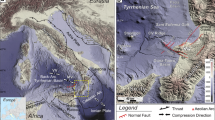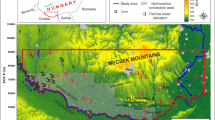Abstract
Geothermal activities are often associated with hydrothermal deposits and hydrothermal features that could aid in geothermal exploration. As a case study, this paper is concerned mainly with the factors controlling the hydrothermal activities and deposits in the Hammam Faraun (HF) area, Gulf of Suez rift, Egypt. In addition to dolomites, hot spring travertine deposits recorded for the first time in this area are emphasized. The proposed conceptual models illustrated that these deposits are confined to the damage zone of the Hammam Faraun fault (HFF). The main factors controlling the hydrothermal activities through time are: syn-rift volcanic activities related to shallow magma chamber bounded to the lithosphere, variable fluid conditions and nature of hydrothermal circulation through HF fault system. At rift initiation, sea water percolated along the CLB fault (a clysmic fault parallel to HFF), reached the Nubian Sandstone and Eocene Carbonate aquifers, mixed with their water, heated and arose along the HFF. The hydrothermal deposits related to fluid circulation at this time are represented by stratabound dolomite. At rift climax, the massive dolostone was formed from coastal lakes mixed water. These dolomitizing lakes occupied the topographically low area at the flank of HF relay ramp. With the beginning of post rifting time, travertine deposits were developed from fluids inside spring lakes during the Pleistocene pluvial period. This sequential development of dolomitization, travertine, and hot fluid flow in HF area would suggest continuity of geothermal activities since the rift initiation until present. Therefore, this study may be considered as a guiding model for further proper evaluation of geothermal energy resources of HF area in particular and geothermal systems in rift basins in general.











Similar content being viewed by others
References
Abdel Zaher MA, Ehara S, El-Qady G (2011) Conceptual model and numerical simulation of the hydrothermal system in Hammam Faraun hot spring, Sinai Peninsula. Egypt Arab J Geosci 4(1–2):161–170
Abdel Zaher MA, Saibi H, Nishijima J, Fujimitsu Y, Mesbah H, Ehara S (2012) Exploration and assessment of the geothermal resources in the Hammam Faraun hot spring, Sinai Peninsula. Egypt J Asian Earth Sci 45:256–267
Atya MA, Khachay OA, Abdel Latif A, Khachay OY, El-Qady GM, Taha AI (2010) Geophysical contribution to evaluate the hydrothermal potentiality in Egypt: case study: Hammam Faraun and Swiera, Sinai. Egypt Earth Sci Res J 14(1):44–62
Bellani S, Brogi A, Lazzarotto A, Liotta D, Ranalli G (2004) Heat flow, deep temperatures and extensional structures in the Larderello geothermal field (Italy): constraints on geothermal fluid flow. J Volcanol Geotherm Res 132:15–29
Boden DR (2017) Geologic fundamentals of geothermal energy. CRC Press, p 425
Bosworth W, McClay K (2001) Structural and stratigraphic evolution of the Gulf of Suez rift, Egypt: a synthesis. In: Ziegler PA, Cavazza W, Roberston AHF, Crasquin-Soleau S (eds) Peri-Tethys Memoir 6: Peri-Tethyan rift/wrench basins and passive margins. Mémoires du Muséum National d’Histoire Naturelle de Paris, pp 567–606
Boulos F (1989) Geothermal development of Hammam Faraun hot spring, Sinai-Egypt. In International conference on applications of solar and renewable energy, 12 p
Brogi A, Capezzuoli E (2009) Travertine deposition and faulting: the fault-related travertine fissure ridge at Terme S. Giovanni, Rapolano Terme (Italy). Int J Earth Sci (geol Rundsch) 98:931–947
Caboi R, Cidu R, Fanfani L, Zuddas P, Zuddas PP (1991) Geochemistry of the funtana maore travertines (Central Sardinia, Italy). Miner Petrog Acta 34:77–93
Caine JS, Evans IP, Forster CB (1996) Fault zone architecture and permeability structure. Geology 24:1025–1028
Chafetz HS, Folk RL (1984) Travertines: depositional morphology and the bacterially constructed constituents. J Sediment Petrol 54:289–316
De Deckker P, Last WM (1988) Modern dolomite deposition in continental, saline lakes, western Victoria. Austr Geol 16(1):29–32
El Ramly MF (1969) Recent review of investigations on the thermal and mineral springs. UAR XXIII Int Geol Cong 19:201–213
El-Fiky AA (2009) Hydrogeochemistry and geothermometry of thermal groundwater from the Gulf of Suez Region. Egypt JKAU Earth Sci 20(2):71–96
El-Qady GM, Ushijima K, Ahmad ES (2000) Delineation of a geothermal reservoir by 2D inversion of resistivity data at Hamam Faraun Area, Sınai, Egypt. In: Proceedings of World Geothermal Congress, Kyushu-Tohoku, Japan pp 1103–1108
Flügel E (2004) Microfacies of carbonate rocks. Springer, p 976
Folk RL (1994) Interaction between bacteria, nannobacteria, and mineral precipitation in hot springs of central Italy. Géogr Phys Quat 48:233–246
Ford TD, Pedley HM (1996) A review of tufa and travertine deposits of the world. Earth Sci Rev 41:117–175
Gawthorpe RL, Jackson CAL, Young MJ, Sharp IR, Moustafa AR, Leppard CW (2003) Normal fault growth, displacement localisation and the evolution of normal fault populations: the Hammam Faraun fault block, Suez rift. Egypt J Struct Geol 25(6):883–895
Guo L, Riding R (1998) Hot-spring travertine facies and sequences, Late Pleistocene, Rapolano Terme, Italy. Sedimentology 45:163–180
Hirani J (2014) Diagenetic evaluation of fault/fracture related dolomitisation, Cretaceous-Eocene, Hammam Faraun Fault Block, Gulf of Suez. Ph.D. thesis, University of Manchester, Manchester, United Kingdom, 295 p
Hirani J, Bastesen E, Boyce A, Corlett H, Gawthorpe R, Hollis C, John CM, Robertson H, Rotevatn A, Whitaker F (2018)a Controls on the formation of stratabound dolostone bodies, Hammam Faraun Fault block, Gulf of Suez. Sedimentology 65(6):973–2002
Hirani J, Bastesen E, Boyce A, Corlett H, Eker A, Gawthorpe R, Hollis C, Korneva I, Rotevatn A (2018b) Structural controls on non fabric-selective dolomitization within rift-related basin-bounding normal fault systems: Insights from the Hammam Faraun Fault Gulf of Suez Egypt. Basin Res 30(5):990–1014
Hollis C, Bastesen E, Boyce A, Corlett H, Gawthorpe R, Hirani J, Rotevatn A, Whitaker F (2017) Fault-controlled dolomitization in a rift basin. Geology 45(3):219–222
Issar A, Rosenthal E, Eckstein Y, Bogoch R (1971) Formation waters, hot springs and mineralization phenomena along the eastern shore of the Gulf of Suez. Bull Int Assoc Sci Hydrol 16:25–44
Kerrich R (1986) Fluid infiltration into Fault Zones: chemical, isotopic and mechanical effects. Pageoph 124:225–268
Kitano Y (1963) Geochemistry of calcareous deposits found in hot springs. J Earth Sci Nagoya Univ 11:68–100
Korneva I, Bastesen E, Corlett H, Eker A, Hirani J, Hollis C, Gawthorpe RL, Rotevatn A, Taylor R (2018) The effects of dolomitization on petrophysical properties and fracture distribution within rift-related carbonates (Hammam Faraun Fault Block, Suez Rift, Egypt). J Struct Geol 108:108–120
Kurlov MG (1928) Classification of mineral waters of Siberia. Tomsk, USSR
Langelier WF, Ludwig HF (1942) Graphic method for indicating the mineral character of natural waters. J Am Water Works Assoc 34:335–352
Lashin A (2013) A preliminary study on the potential of the geothermal resources around the Gulf of Suez. Egypt Arab J Geosci 6(8):2807–2828
Magaritz M, Issar A (1973) Carbon and oxygen isotopes in epigenetic hydrothermal rocks from Hamam-El-Farun. Sinai Chem Geol 12(2):137–146
Mehmood M, Yaseen M, Khan EU, Khan JM (2018) Dolomite and dolomitization model - a short review. Int J Hydro 2(5):549–553
Moeck IS (2014) Catalog of geothermal play types based on geologic controls. Renew Sustain Energy Rev 37:867–882
Morgan P, Swanberg CA (1979) Heat flow and the geothermal potential of Egypt. Pageoph 117:213–225
Morgan P, Boulos FK, Swanberg CA (1983) Regional geothermal exploration in Egypt. Geophys Prospect 31(2):361–376
Morgan P, Boulos FK, Hennin SF, El-Sherif AA, El-Sayed AA, Basta NZ, Melek YS (1985) Heat flow in eastern Egypt: the thermal signature of a continental breakup. J Geodyn 4:107–131
Moustafa AM (1976) Block faulting in the Gulf of Suez. In: Proceedings of the 5th Egyptian General Petroleum Corporation Exploration Seminar, Cairo, Egypt, 35 p
Moustafa AR (2004) Geologic maps of the eastern side of the Suez rift (western Sinai Peninsula), Egypt. AAPG/Datapages. Inc. GIS Series (Geologic maps and cross-sections in digital format on CD and explanatory notes for the geologic maps)
Moustafa AR, Abdeen MM (1992) Structural setting of the Hammam Faraun Block, eastern side of the Suez rift. J Univ Kuwait (sci) 19:291–310
Moustafa AR, Khalil SM (2017) Control of extensional transfer zones on syntectonic and post-tectonic sedimentation: implications for hydrocarbon exploration. J Geol Soc (London) 174:318–335
O’Neil JR, Barnes I (1971) C13 and O18 compositions in some freshwater carbonates associated with ultramafic rocks and serpentinites: western United States. Geochim Cosmochim Acta 35:687–697
Patton TL, Moustafa AR, Nelson RA, Abdine SA (1994) Tectonic evolution and structural setting of the Suez Rift. In: Landon SM (ed) Interior Rift Basins. AAPG Mem, pp 9–55
Pentecost A (2003) Cyanobacteria associated with hot spring travertines. Can J Earth Sci 40(11):1447–1457
Rotevatn A, Bastesen E (2014) Fault linkage and damage zone architecture in tight carbonate rocks in the Suez Rift (Egypt): Implications for permeability structure along segmented normal faults. Geol Soc London Spec Publ 374:79–95
Scholle PA, Ulmer-Scholle DS (2003) A Color Guide to the Petrography of Carbonate Rocks: Grains, Textures, Porosity, Diagenesis. AAPG Memoir 77, AAPG, Tulsa, Oklahoma
Severin KP (2004) Energy dispersive spectrometry of common rock forming minerals. Kluwer Academic Publishers, p 225
Shallaly NA, Beier C, Haase KM, Hammed MS (2013) Petrology and geochemistry of the Tertiary Suez rift volcanism, Sinai. Egypt J Volcanol Geotherm Res 267:119–137
Sharp IR, Gawthorpe RL, Underhill JR, Gupta S (2000) Fault propagation folding in extensional settings: examples of structural style and synrift sedimentary response from the Suez rift, Sinai. Egypt Geol Soc Am Bull 112:1877–1899
Shawky A (2020) Potentiality of geothermal energy resources of hammam Faraun area, south sinai governorate. Thesis registered at faculty of science, Cairo University, Egypt
Sturchio NC, Arehart GB, Sultan M, Sano Y, AboKamar Y, Sayed M (1996) Composition and origin of thermal waters in the Gulf of Suez area. Egypt Appl Geochem 11:471–479
Tucker ME (1991) Dolomitization, dedolomitization and silicification. In: Sedimentary petrology: an introduction to the origin of sedimentary rocks, 260 p
Tucker ME, Wright VP (1990) Dolomites and Dolomitization Models. In: Carbonate Sedimentology, 482 p
Warren J (2000) Dolomite: occurrence, evolution and economically important associations. Earth Sci Rev 52(1–3):1–81
Weiszburg TG, Tóth E, Beran A (2004) Celadonite, the 10-Å green clay mineral of the manganese carbonate ore, Úrkút. Hungary Acta Mineral-Petrogr 45(1):65–80
Wohletz K, Heiken G (1992) Volcanology and geothermal energy. University of California Press, p 432
Acknowledgements
This work is a part of a master’s thesis of the first author registered at faulty of science, Cairo University. The authors are sincerely grateful to Prof. Shawky Sakran (Professor of Structural Geology at Cairo University) for his guidance and valuable discussion during all the phases of this work. Special thanks are given to the staff of the institute of geological sciences at Jagiellonian University in Poland for all their help during the Erasmus+ mobility scholarship of the first author at their institute where a large part of this work was performed. Prof. Mohamed Hamadan (Professor of Geoarchaeology and Quaternary Geology at Cairo University) is also greatly acknowledged for his constructive discussion on travertine. The authors thank the helpful discussion with Dr. Hend Abu Salem (Lecturer of Hydrogeology at Cairo University) that enhanced the hydrochemical interpretation. The support from the Egyptian Armed Forces during field trips is highly acknowledged and appreciated.
Funding
The field work was financially supported by Cairo University.
Author information
Authors and Affiliations
Corresponding author
Additional information
Publisher's Note
Springer Nature remains neutral with regard to jurisdictional claims in published maps and institutional affiliations.
Rights and permissions
About this article
Cite this article
Shawky, A., El-Anbaawy, M.I., Shallaly, N.A. et al. Continuous fluid circulation in Hammam Faraun geothermal system, Gulf of Suez rift, Egypt: evidences from hydrothermal deposits along rift-related faults. Carbonates Evaporites 36, 57 (2021). https://doi.org/10.1007/s13146-021-00721-w
Accepted:
Published:
DOI: https://doi.org/10.1007/s13146-021-00721-w





